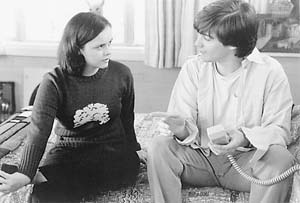ICE STORM, THE
(director: Ang Lee; screenwriter: James Shamus; cinematographer: Frederick Elmes; editor: Tim Squyres; cast: Kevin Kline (Ben Hood), Sigourney Weaver (Jane Carver), Joan Allen (Elena Hood), Jamey Sheridan (Jim Carver), Christina Ricci (Wendy Hood), Elijah Wood (Mikey Carver), Adam Hann-Byrd (Sandy Carver), Tobey Maguire (Paul Hood); Runtime: 113; Good Machine/Fox Searchlight; 1997)
“Lee was born in Taiwan and did not live here until 1978, yet he is able to capture a slice of Americana in the early ’70s and what it was like to be a rich American in the middle of such great social change.”
Reviewed by Dennis Schwartz
The story takes place in the wealthy WASP-ish ‘burb of New Canaan, Connecticut, on Thanksgiving week, 1973, when there is an ice storm and a catastrophe is to follow that shakes up this upscale town. It is through the eyes of two families who are friends and neighbors that we follow the events leading up to the tragedy. The first family consists of Ben (Kline) and Elena Hood (Joan) and their children, the sexually curious 14-year-old Wendy (Ricci) and the 16-year-old preppie Paul (Tobey); the other family consists of Jane (Sigourney) and Jim Carver (Jamey) and their boys — the brilliant high school student Mikey (Elijah) and the younger son, the troubled and introverted Sandy (Adam).
This drama is played out against the negativity of the current Nixon administration as viewed on many campus’ across the country, with some of the teens reflecting their parents’ conservative political views and others vehemently on the opposite side. This is also a film about the parents’ dissatisfaction with their empty lives. This dissatisfaction makes it possible for an affair between Ben and Jane to take place. But even that affair is stale (he can’t stop talking in bed and she chillingly tells him to keep quiet, “You are boring me, I have a husband and I don’t need another one”).
The lives of the children are scrutinized in the same way their parents’ lives are, and the results are almost identical. The children despite some of them being discontented with the outside world are almost mirror images of their parents — unwilling to be honest with themselves, or too honest with themselves for their own good. Meanwhile, for most, the revolutionary spirit of the times seems to be passing them by.
Tobey struggles to relate with girls as he is awkward and unsure of what to do or say. He is at the phase of his life where he is experimenting with drugs in the stupidest of ways; Wendy is unwisely looking to explore sex, but unaware of the consequences of her decisions; Mickey is reckless and unsure of how to handle his playful sense of adventure and freedom; Sandy is all bottled-up inside, wanting to love and be loved, while at the same time being full of anger.
The introduction of nature into their lives brings about a stark reality, as it comes in the form of the Thanksgiving ice storm. The ice storm is magnificently opulent in its whitish, bluish, and gray colors (the ice was artificially made, but it looks only too real). It symbolically represents the truth that can’t be denied, no matter what games the adults (wife-swapping) and children (touching their private parts) play. The beauty of the ice storm is even more menacing and attractive when it is added to the more placid beauty of the town’s countryside; but it is also dangerous as we see how the one suburbanite truly influenced by the beauty of the storm, also succumbs to it.
Lee was born in Taiwan and did not live here until 1978, yet he is able to capture a slice of Americana in the early ’70s and what it was like to be a rich American in the middle of such great social change. It is amazing that this film was made by a foreigner (It still surprises me, though Hollywood has a rich history of foreigners doing just that; examples would be, messieurs Lang and Sirk).
The characters are intricately drawn together; each is complex and not reduced to caricature. Kline’s performance is central to the film, he reflects on who he thinks he is supposed to be and why his marriage has gone cold (he’s a metaphor for the white middle-class male). While Ricci’s performance is simply breathtaking, as she appears to be the only one of the teen group who really feels what is going on politically and socially.
These are successful people, and there is a reason why they are successful. We see how they are able to go after what they want and get it, the only thing that seems to be alluding them is peace of mind.
This film is to be admired for its icy observations of suburban life, and in letting us clearly see the intensity and restlessness that lies behind the carefully manicured persona of the rich. Its use of the ice storm’s raw power, in all its beauty and danger, as a metaphor on the characters’ liabilities was both well-utilized and, at the same time, utilized too much. The film can be slightly faulted for putting too much weight on the ice storm and its symbolical message and for trying to make too much of the comparison between the children and the parents as if they all were similar types, thereby not doing enough justice to either characterization.

REVIEWED ON 9/23/98 GRADE: B